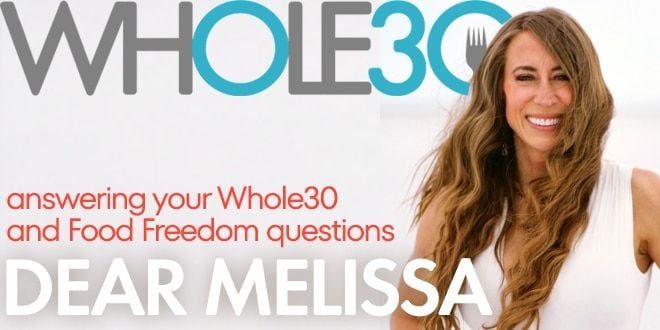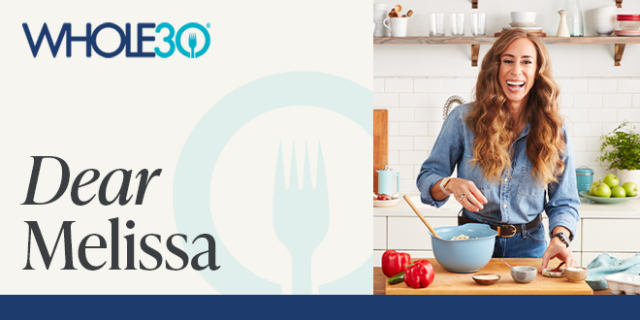Dear Melissa,
I’m on Day 15 of my second Whole30, and I’m wondering if there is such a thing as eating too much fat. Can I cook some eggs in avocado oil and top with hollandaise sauce? Or cook a skillet meal in ghee, but also drizzle it with Whole30-compatible ranch? The Whole30 Meal Template says 1-2 thumb sized portions of fat per meal, so am I on the right track? -Megan, Calgary, AB
Dear Megan,
The short answer is sure, it’s possible to eat more fat than your body can effectively process in any one sitting. (If you dump a whole bottle of Ranch over your salad or add a whole can of coconut milk to your Plant-Based Whole30 smoothie, your digestive tract will likely let you know.) But if you’re listening to your body and using the Whole30 meal template as a general guide, you don’t have to stress about it. Here’s the longer answer:
Trust your satiety signals
When you eat whole foods, your body has built-in systems to help you determine what’s “too much” for your context. (Have you ever tried to eat a giant steak, only to realize halfway through that you just can’t eat any more? That’s the protein, fat, and micronutrition in the steak sending signals to your gut and brain saying, “we’ve had enough.”)
In fact, it’s a lot harder to overeat nutrient-dense whole foods like eggs, avocado, and Whole30 mayo than it is to overconsume ultra-processed foods like potato chips, French fries, or ice cream. It’s even harder to overeat if you enjoy your Whole30 meal at the table, eating conscientiously and allowing those satiety signals to catch up to your brain. (Compare that to wolfing down a drive-through burger and fries in the car between errands.)
If you’re unsure of how to connect to your body’s “hungry” and “full” signals, that’s likely the product of the kinds of foods you were eating before the Whole30. (It’s hard to do with highly processed, nutrient-poor, extra-salty/fatty/sweet stuff—what we call “foods with no brakes.”)
The Whole30 can help restore those natural satiety signals. After a weeks or two, you’ll be able to hear (and trust) when your body says, “I’m hungry” and stop eating when you’re full.
To be honest, it’s much more common that people under-eat fat on their Whole30. After years of “fat is bad” messaging coming from the media (and maybe even your own doctor), people come into the Whole30 afraid of dietary fat. They’re so used to shopping for low-fat or zero-calorie everything that I often see people not eating enough fat (and therefore not enough energy or total calories) during their first Whole30. That’s why we created the guidelines in our meal template.
Signs of too much fat
However, it is possible to eat too much fat on a Whole30, and that can negatively affect your hunger levels, energy, and digestion. We see this most often when people mindlessly snack on nuts and seeds. (Think “spooning out half a jar of almond butter while watching a movie,” or “snacking on roasted, salted cashews right out of the bag while driving.”)
It’s also easier to overconsume fat if it’s in liquid format. Drinking your food can get that energy into your body faster than your gut can send signals to your brain. It’s easy to drink a lot of fat from canned coconut milk or gobs of almond butter blended into a smoothie, because they go down so fast. (That’s why bodybuilders use lots of shakes when they want to put on muscle.)
If you were to consume a meal that contained too much fat for your context, you’d likely experience digestive distress (bloating, gas, diarrhea); oily stools; and sluggishness.
The Whole30 meal template
However, what you are describing doesn’t sound at all like that context. In the case of eating fat as part of a balanced Whole30 meal, you can generally assume that things even out in the wash. One of your meals may be higher fat, while the next is naturally lower in fat as a result of your protein, choice of sauce, or cooking method.
In summary, I wouldn’t worry about eating too much fat on the Whole30. Use the meal template as a guide, rotate your protein and fat choices, and pay attention to your energy, hunger, and digestion. If your hunger is appropriate (you’re not overly stuffed after a meal, but not ravenous two hours later), your energy is getting steadier, your digestion is smoothing out, and you’re feeling satisfied with your food, keep doing what you’re doing!
Best in health,
Melissa















